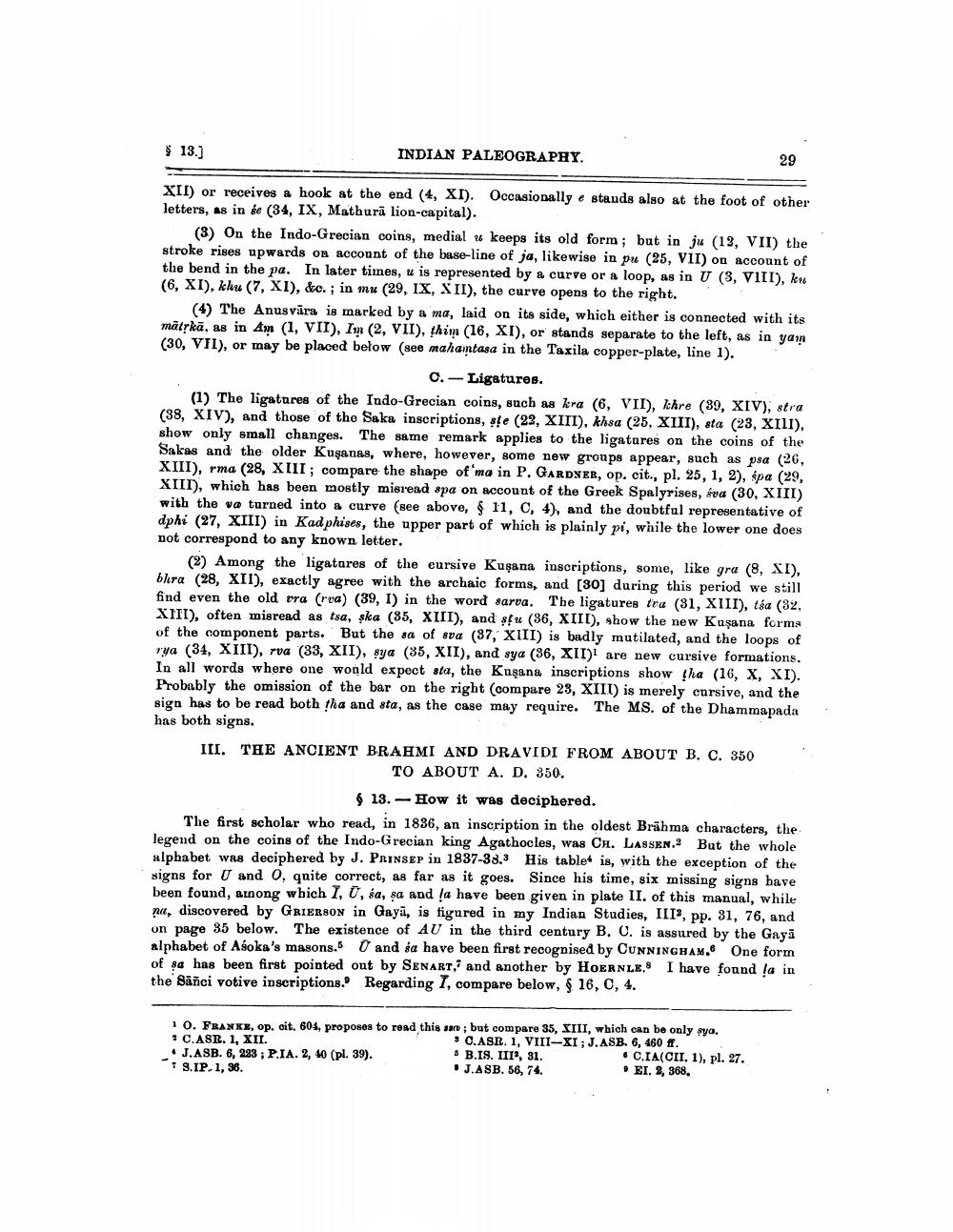________________
$
13.)
INDIAN PALEOGRAPHY.
XII) or receives a hook at the end (4, XI). Occasionally e stands also at the foot of other letters, as in de (34, IX, Mathura lion-capital).
(3) On the Indo-Grecian coins, medial u keeps its old form ; but in ju (13, VII) the stroke rises apwards on account of the base-line of ja, likewise in pu (25, VII) on account of the bend in the pa. In later times, u is represented by a curve or a loop, as in U (3, VIII), ku (6, XI), khu (7, XI), &c.; in mu (29, IX, XII), the curve opens to the right.
(4) The Anusvára is marked by a ma, laid on its side, which either is connected with its mātskā, as in An (1, VII), Im (2, VII), thin (16, XI), or stands separate to the left, as in yain (30, VII), or may be placed below (see mahamtasa in the Taxila copper-plate, line 1).
C. - Ligatures. (1) The ligatures of the Indo-Grecian coins, such as kra (6, VII), Khre (89, XIV), stra (38, XIV), and those of the Saka inscriptions, s'e (22, XIII), khsa (25, XIII), sta (23, Xill), show only small changes. The same remark applies to the ligatures on the coins of the Sakas and the older Kuşanas, where, however, some new groups appear, such as psa (26, XIII), rma (28, XIII; compare the shape of ma in P. GARDNER, op. cit., pl. 25, 1, 2), spa (29, XIII), which has been mostly misread spa on account of the Greek Spalyrises, sva (30, XIII) with the va turned into & curve (see above, $ 11, C, 4), and the doubtful representative of dphi (27, XIII) in Kad phises, the upper part of which is plainly pi, while the lower one does not correspond to any known letter.
(2) Among the ligatares of the cursive Kuşana inscriptions, some, like gra (8, XI), blura (28, XII), exactly agree with the archaic forms, and [30] during this period we still find even the old ora (roa) (39, I) in the word sarva. The ligatures tra (31, XIII), téa (32, XIII), often misread as tsa, ska (85, XIII), and stu (36, XIII), show the new Kuşana forma of the component parts. But the sa of sva (37, XIII) is badly mutilated, and the loops of rya (34, XIII), rva (33, XII), sya (35, XII), and sya (36, XII) are new cursive formations. In all words where one would expect sta, the Kuşana inscriptions show tha (16, X, XI). Probably the omission of the bar on the right (compare 23, XIIT) is merely cursive, and the sign has to be read both tha and sta, as the case may require. The MS. of the Dhammapada has both signs. III. THE ANCIENT BRAHMI AND DRAVIDI FROM ABOUT B. C. 350
TO ABOUT A. D. 350.
13. - How it was deciphered. The first scholar who read, in 1836, an inscription in the oldest Brühma characters, the legend on the coins of the Indo-Grecian king Agathocles, was Ch. LASSEN.2 But the whole alphabet was deciphered by J. PRINSEP in 1837-33. His tablet is, with the exception of the signs for U and 0, quite correct, as far as it goes. Since his time, six missing signs have been found, among which I, U, sa, sa and a have been given in plate II. of this manual, while nu, discovered by GRIERBON in Gayà, is figured in my Indian Studies, III, pp. 31, 76, and on page 35 below. The existence of AU in the third century B. C. is assured by the Gaya alphabet of Asoka's masons. U and sa have been first recognised by CUNNINGHAM. One form of sa has been first pointed out by SENART, and another by HOERNLE, I have found la in the Sāñci votive inscriptions. Regarding I, compare below, $ 16, C, 4.
10. FRANXX, op. cit. 604, proposes to read this sao; but compare 35, XIII, which can be only sya. + C.ASR. 1, XII.
C.ASR. 1, VIII-XI ; J.ASB. 6, 460 ff. • J.ASB. 6, 223 ; P.IA. 2, 40 (pl. 39).
5 B.IS. III, 31.
. C.IA(CII. 1), pl. 27. • S.IP. 1, 36.
. J.ASB. 56, 74.
EI, 2, 368.




